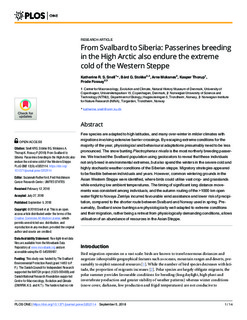| dc.contributor.author | Snell, Katherine R. S. | |
| dc.contributor.author | Stokke, Bård Gunnar | |
| dc.contributor.author | Moksnes, Arne | |
| dc.contributor.author | Thorup, Kasper | |
| dc.contributor.author | Fossøy, Frode | |
| dc.coverage.spatial | Svalbard, Norway, Asia | nb_NO |
| dc.date.accessioned | 2018-09-21T11:06:08Z | |
| dc.date.available | 2018-09-21T11:06:08Z | |
| dc.date.created | 2018-09-09T08:48:50Z | |
| dc.date.issued | 2018 | |
| dc.identifier.issn | 1932-6203 | |
| dc.identifier.uri | http://hdl.handle.net/11250/2563909 | |
| dc.description.abstract | Few species are adapted to high latitudes, and many over-winter in milder climates with migrations involving extensive barrier crossings. By escaping extreme conditions for the majority of the year, physiological and behavioural adaptations presumably need to be less pronounced. The snow bunting Plectrophenax nivalis is the most northerly breeding passerine. We tracked the Svalbard population using geolocators to reveal that these individuals not only breed in environmental extremes, but also spend the winters in the severe cold and highly stochastic weather conditions of the Siberian steppe. Migratory strategies appeared to be flexible between individuals and years. However, common wintering grounds in the Asian Western Steppe were identified, where birds could utilise vast crop- and grasslands while enduring low ambient temperatures. The timing of significant long distance movements was consistent among individuals, and the autumn routing of the >1000 km open water flight to Novaya Zemlya incurred favourable wind assistance and lower risk of precipitation, compared to the shorter route between Svalbard and Norway used in spring. Presumably, Svalbard snow buntings are physiologically well-adapted to extreme conditions and their migration, rather being a retreat from physiologically demanding conditions, allows utilisation of an abundance of resources in the Asian Steppe. | nb_NO |
| dc.language.iso | eng | nb_NO |
| dc.relation.uri | https://journals.plos.org/plosone/article?id=10.1371/journal.pone.0202114 | |
| dc.rights | Navngivelse 4.0 Internasjonal | * |
| dc.rights.uri | http://creativecommons.org/licenses/by/4.0/deed.no | * |
| dc.title | From Svalbard to Siberia: Passerines breeding in the High Arctic also endure the Extreme cold of the Western Steppe | nb_NO |
| dc.title.alternative | From Svalbard to Siberia: Passerines breeding in the High Arctic also endure the Extreme cold of the Western Steppe | nb_NO |
| dc.type | Journal article | nb_NO |
| dc.type | Peer reviewed | nb_NO |
| dc.description.version | publishedVersion | nb_NO |
| dc.rights.holder | © 2018 Snell et al. | nb_NO |
| dc.subject.nsi | VDP::Zoologiske og botaniske fag: 480 | nb_NO |
| dc.subject.nsi | VDP::Zoology and botany: 480 | nb_NO |
| dc.source.volume | 13 | nb_NO |
| dc.source.journal | PLoS ONE | nb_NO |
| dc.source.issue | 9 | nb_NO |
| dc.identifier.doi | https://doi.org/10.1371/journal.pone.0202114 | |
| dc.identifier.cristin | 1607860 | |
| dc.relation.project | Svalbards miljøvernfond: 14/63 | nb_NO |
| cristin.unitcode | 7511,2,0,0 | |
| cristin.unitcode | 7511,3,0,0 | |
| cristin.unitname | Avdeling for terrestrisk økologi | |
| cristin.unitname | Avdeling for akvatisk økologi | |
| cristin.ispublished | true | |
| cristin.fulltext | original | |
| cristin.qualitycode | 1 | |

